
* In the 1960s, both France and Britain started looking for a new maritime patrol / antisubmarine warfare aircraft. The French Breguet firm came up with a new twin-turboprop design, the "Atlantic", which saw service with a number of nations. The British Hawker-Siddeley firm took a different approach, modifying the Comet four-jet airliner into the "Nimrod", which served into the 21st century. This document provides a history and description of the Atlantic and Nimrod.
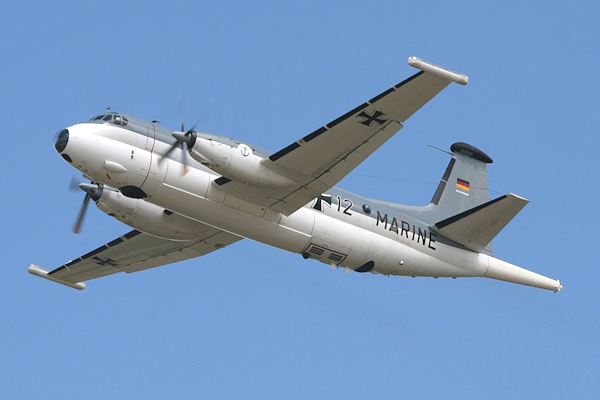
* The Lockheed P-2V Neptune was standard maritime patrol / antisubmarine warfare (ASW) aircraft of NATO in the early days of the Cold War, but by the mid-1950s, it was clearly in decline. In 1958, NATO issued a specification for a replacement, with the French Breguet firm winning the contract with its "Breguet 1150" proposal. Production of the "Atlantic", as it was named, was to be performed by a multinational consortium, which was given the name of "Societe d'Etude et de Construction de Breguet ATlantique (SECBAT)". The US provided financial assistance.
Two prototypes were built, the first performing its maiden flight at Toulouse on 21 October 1961, the second following in early 1962. Two preproduction aircraft, with a longer fuselage than the prototypes, followed in 1963 and 1964. By that time, France had ordered 40 Atlantics and Germany had ordered 20, with introduction to service in 1965. When the "Atlantic 2" was later introduced, this first production model became the "Atlantic 1", or informally "ATL1" for short.
An initial order for 60 ATL1s -- 40 for France and 20 for Germany -- was placed in 1963, with deliveries starting in 1965 and continuing to 1968. The Netherlands then ordered nine ATL 1s and Italy ordered 18, with deliveries from 1972 to 1974. That gave total ATL1 production of 89 aircraft, including the two prototypes. Incidentally, Breguet merged with Dassault in 1971, with the resulting company known as "Dassault-Breguet", and the Atlantic 1 sometimes being called a Dassault product.
* In any case, the Atlantic 1 was a mid-wing all-metal aircraft, featuring considerable use of honeycomb sandwich, with twin turboprop engines and retractable tricycle landing gear. It had a "double bubble" fuselage, like two tubes mated together top and bottom, the top tube being larger in diameter. The top fuselage was pressurized, while the bottom fuselage was unpressurized, being intended primarily for a weapons bay -- 9 meters (27 feet 6 inches) long -- with a sonobuoy dispenser array behind it. The weapons bay doors retracted up alongside the fuselage to reduce drag and to keep from obstructing the radar. The dispenser tubes could drop sonobuoys, flares, marker buoys, smoke bombs, and submarine detection charges.
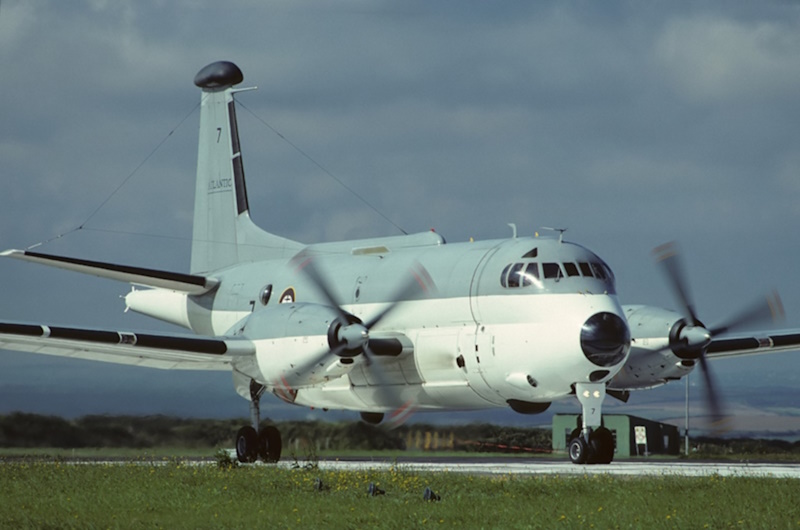
The ATL1 was powered by twin Rolls-Royce Tyne RTy.20 Mark 21 turboprops, with 4,555 eKW (6,105 eHP) each, driving four-bladed H8D propellers. The engines were built under license by SNECMA of France. There were two integral fuel tanks in each wing, total fuel capacity being 21,000 liters (5,548 US gallons). Apparently wingtip tanks could be fitted in principle, but it's hard to find any pictures of an ATL1 with them. There was an AiResearch auxiliary power unit (APU) turbine in the front right fuselage, forward of the weapons bay, marked by a prominent exhaust. The APU was used for engine starting and ground power.
The wing was flat inboard of the engines, with a dihedral outboard of the engines. Each wing had an aileron outboard, with flaps in three sections on three-quarters of the trailing edge -- one section inboard of the engines, two sections outboard. There were three spoilers ahead of the outboard flaps. Sources also mention top and bottom air brakes on each wing, but it's hard to find specifics. The tail assembly was of conventional configuration, with elevators and rudder, the tailplane having a prominent dihedral. There were no trim tabs, trimming being by offset of the flight surfaces. All flight control surfaces were hydraulically actuated. There were de-icing boots on the leading edges of all the flight surfaces. The props and engine inlets were electrically de-iced; presumably, so was the windshield, but it's hard to determine from sources.
The nose gear retracted backwards, while the main gear retracted forwards into the engine nacelles. All gear assemblies had twin wheels and were hydraulically actuated. There were 12 crew, including pilot, copilot, and navigator; a tactical coordinator to run the operational show; plus three observers and five systems operators. Access to the crew compartment was through a hatch under the tail that had an "airstair" door. There was an emergency escape hatch over each wing, as well as above and below the flight deck. The nose was glazed for an observer, while there was an observer bubble on each side of the upper rear fuselage. The ATL 1 was pressurized and climate-conditioned. It had a toilet, galley, and rest area; it could carry a second crew for long patrols.
Flight avionics systems were conventional, including military radios, identification friend or foe (IFF) system, autopilot, and navigation / landing aids. A search radar was housed in a retractable radome under the forward fuselage, while a magnetic anomaly detector (MAD) system was housed in a tail boom, and an electronic support measures (ESM) system -- to locate and characterize radio emitters -- was carried in a "football" fairing on top of the tailfin. Weapons loads included eight homing torpedoes, 12 depth charges, naval mines, gravity bombs, or eight parachutable rescue packs.
The ATL1 could be fitted with two stores pylons under each outer wing for carrying torpedoes, depth charge, and other munitions -- including, it seems, wire-guided AS-12 missiles -- but photos suggest that the pylons were rarely fitted, though it appears an outboard pylon was sometimes fitted to carry a searchlight pod.
___________________________________________________________________
DASSAULT ATLANTIC 1:
___________________________________________________________________
wingspan:
36.3 meters (119 feet 1 inch)
length:
31.75 meters (104 feet 2 inches)
height:
11.3 meters (37 feet 2 inches)
empty weight:
25,000 kilograms (55,115 pounds)
max take-off weight:
44,500 kilograms (98,105 pounds)
max speed at altitude:
660 KPH (410 MPH / 355 KT)
patrol speed:
315 KPH (195 MPH / 170 KT)
service ceiling:
10,000 meters (33,000 feet)
range:
9,000 kilometers (5,590 MI / 4,855 NMI)
endurance:
18 hours
___________________________________________________________________
The primary missions of the Atlantic 1 were anti-submarine patrol and anti-surface warfare, with secondary roles including search and rescue, mine laying and detection, and long-range maritime surveillance.
Five of the German ATL1s were configured for the signals intelligence (SIGINT) mission, being primarily flown over the Baltic Sea. They retained the MAD boom, the tailfin football, and the search radar -- but they acquired an antenna dome under the bomb bay and wingtip pods, with the sonobuoy dispenser faired over. The SIGINT system was obtained from E-Systems of the USA, and its installation came along with a number of US government on its use and handiling. The German ATL1s notably performed surveillance flights along the borders with the East Bloc, and over the Balkans during the wars of the 1990s. It seems the French also used Atlantic 1s for SIGINT, but apparently not with as many changes. They were used in French military interventions in Africa.
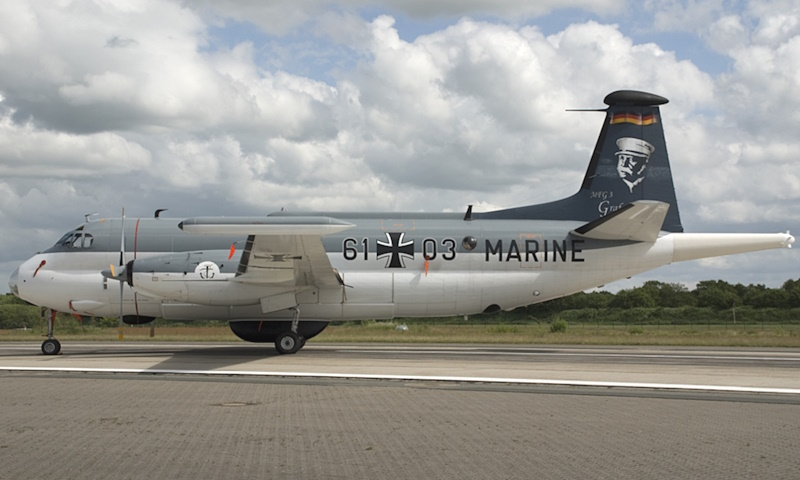
All French ATL1s had been retired by 1996, being replaced by the Atlantic 2. Pakistan obtained three ex-French ATL1s in 1973, plus a fourth in 1986, when the fleet was wired to carry Exocet antiship missiles. The Pakistani ATL1s were upgraded from 1993, the upgrade being defined by Thomson-CSF of France and implemented by Pakistan. The centerpiece of the upgrade was a Thomson CSF Ocean Master radar, a new mission system, along with new flight and mission avionics system. The upgraded machines were redelivered from 1995 to 1999. One of the ATL1s was shot down in 1999 after it strayed into Indian airspace. Three more ATL1s were obtained from France for use as spares hulks. The Pakistani Atlantic 1s were retired in 2012, being replaced by ATR 72MPs.
Of the nine Dutch Atlantic 1s, three were lost in service, with the type retired in 1981, to be replaced by the Lockheed P-3 Orion. The Germans held on to theirs, updating their avionics systems in the early 1980s and then performing a life extension on them in the mid-1990s. They were finally replaced by P-3Cs, obtained from the Netherlands as a stopgap, to be ultimately replaced by the Boeing P-8 Poseidon. Italy retired their last ATL1s in 2017, to be replaced by ATR 72MP patrol aircraft.
BACK_TO_TOP* In 1978, the French Government initiated development of an updated version of the Atlantic, the "Atlantique Nouvelle Generation (ANG)", to later be known simply as the "Atlantic 2 / ATL2". Two prototypes were built as conversions of ATL1s, the first making its initial flight on 8 May 1981, the second following in 1982. 42 were ordered by the French Aeronavale, with initial deliveries in 1988, though only 28 were actually built, last delivery being in 1998. Production of the Atlantic 2 was again shared by the SECBAT consortium set up for the Atlantic 1. Members were Dassault, Aerospatiale, Dornier, MBB, Aeritalia, and Sabca/Sonaca/FN. There were no buyers besides the French Navy.
To keep costs down, the ATL2 featured as few airframe changes as possible, with improvements including structural reinforcement and corrosion protection, the focus being to increase airframe life. It even kept the twin Rolls-Royce Tyne RTy.20 Mark 21 turboprops, though with new composite props. One significant internal change was reducing the number of integral tanks in each wing from three to two, with fuel capacity increased by 10%.
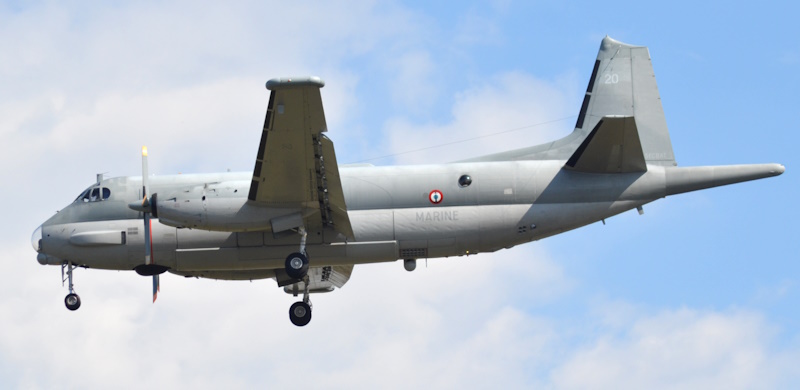
The avionics system was built around a central tactical computer, connected to multiple tactical display systems with their own processing power. The search radar was updated to the Thomson-CSF "Iguane", and there was a forward-looking infrared (FLIR) imager in a turret under the nose, providing a distinctive recognition feature. The sonobuoy receiver, MAD, and ESM systems were all modernized; the prominent football fairing on the tailfin for the ESM was replaced with a small pimple, while ESM antennas were mounted on the wingtips. Along with updated communications systems, the ATL2 had a Link 11 datalink system, and a Global Positioning System / inertial navigation system (GPS-INS).
Stores carriage was effectively the same as that of the ATL1, the only big difference being addition of the Exocet antiship missile as a store. The weight capacity of the wing pylons was also increased -- but again, it's hard to see underwing pylons were fitted, except possibly to carry a searchlight.
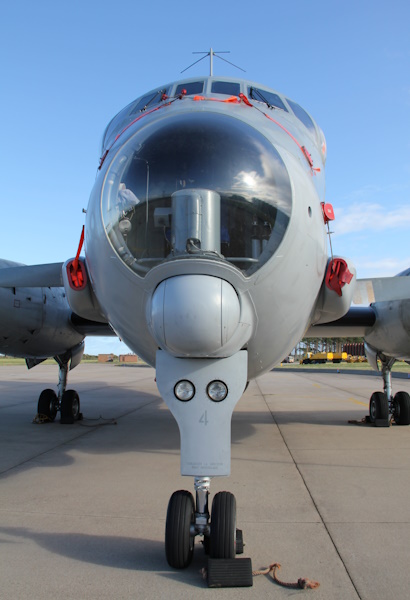
From 2013, the ATL2s were upgraded to "Standard 6" to replace obsolete avionics and other systems, the most significant updates being the Thales Searchmaster RBE2-AA active electronically scanned array radar developed for Dassault Rafale, and a modernized mission system. They were also qualified for new munitions. A "service-life extension program (SLEP)" was also performed to keep the ATL2s into service. Also from 2013, ATL2s were deployed to Africa and Iraq to serve in a tactical support role, performing "intelligence, surveillance and reconnaissance (ISR)" missions, and on occasions even dropping laser-guided bombs.
An "Atlantic 3" was proposed in the 1990s for a British Royal Air Force (RAF) requirement for a new Maritime Patrol Aircraft (MPA), the "ATL3" to feature new engines with six-bladed composite props and comprehensively updated avionics, including a modern "glass cockpit". The RAF didn't buy it; Dassault continued to push the ATL3 until 2005, to then give up and start pushing MPA variants of the larger Dassault Falcon business jets. The ATL2 will serve into the 2030s, but it will be eventually replaced by the Airbus A321MPA patrol aircraft.
BACK_TO_TOP* In 1964, the British Government issued Air Staff Requirement 381, which sought a replacement for the elderly and increasingly decrepit Avro Shackleton Mark 2 maritime patrol aircraft of the Royal Air Force (RAF) -- the Shackleton being a derivative of the Avro Lancaster bomber of World War II. A wide range of proposals were returned for the requirement, the Atlantic being one of them, but in 1965 the government gave the award to Hawker Siddeley, for a maritime patrol version of the De Havilland Comet jetliner. The design had the company designation of "Model 801", and was named "Nimrod" -- the "mighty hunter" of the Old Testament.
De Havilland had been bought up by Hawker Siddeley in 1960, with the last Comet jetliners produced in 1964. Two uncompleted Comet 4C jetliners were completed as Nimrod prototypes, with the four Rolls-Royce Avon turbojet engines replaced by four Rolls-Royce Spey low-bypass fan jets, with greater fuel efficiency -- though one prototype being used for avionics tests did retain the Avons. Initial flight of the first prototype was on 23 May 1967. The RAF obtained 46 production "Nimrod Maritime Reconnaissance (MR) Mark 1" machines, with the first entering service in 1969.
The Nimrod featured substantial airframe changes relative to the Comet 4C -- most notably a weapons bay, achieved by adding a belly fuselage, establishing a "double bubble" fuselage configuration. Other changes included:
The airframe changes demanded a large triangular forward fillet on the tailfin to maintain yaw stability. Electrical power generation capability well exceeded that required by the avionics systems fitted at the outset, to accommodate new avionics down the road.
Stores loads included depth charges, homing torpedoes, mines, dumb bombs, or rescue packs. There was a set of dispenser tubes behind the weapons bay for dropping sonobuoys, floats, flares, and the like. Sonobuoys were dispensed from internal carousels, while two film cameras could also be installed for reconnaissance missions. A hardpoint for fitting a stores pylon was provided on each wing just outboard of the engine nacelles, for carrying an antiship missile or other store.
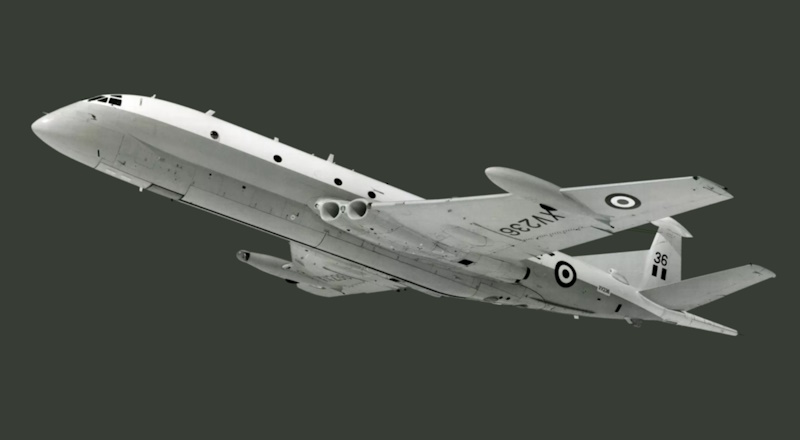
Aircrew consisted of pilot, copilot, flight engineer, two navigators -- one general, one tactical -- and a team of seven mission specialists, including a supervisory officer and six systems operators. An alternate crew could be carried for long missions. The Nimrod could in principle be used as a transport, with some equipment removed and seats installed, but it seems that was rarely if ever done.
The Nimrod was the first jet-powered maritime patrol aircraft in British service. Five squadrons would operate the variant, including one at Luqa in Malta -- though the Malta squadron would be disbanded in 1977, with the RAF withdrawal from the island. UK squadrons were based in Scotland and in Cornwall to patrol far out into the Atlantic.
The Nimrod MR1 carried out three primary roles: Anti-Submarine Warfare (ASW), Anti-Surface Unit Warfare (ASUW), and Search and Rescue (SAR). One of the top-priority missions was to protect Royal Navy ballistic missile submarines, cooperating with Royal Navy frigates and attack submarines for the task. Incidentally, while on patrol station, the Nimrod often shut down the outer two engines to conserve fuel. There was a crossfeed duct between the two engines on each side to allow one to restart the other.
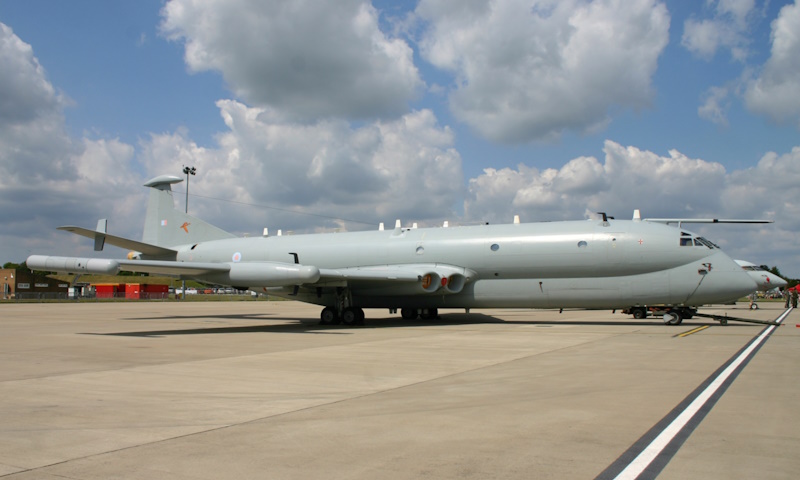
* In addition to the 46 Nimrod MR.1 machines, three more new-build Nimrods were produced as "Nimrod R.Mk.1" SIGINT platforms, replacing Comets and Canberras in that role. They could be easily recognized because the MAD tailboom was removed, being replaced by a much smaller antenna dome; the tailfin "football" fairing was retained. They also had a litter of blade antennas, as well as antenna domes on the front of the leading-edge fuel tanks, the tanks having been a distinctive feature for the Comet 4. It had a flight crew of four -- pilot and co-pilot, pilots, flight engineer, and navigator -- and up to 25 crew handling the SIGINT equipment. They were officially only known as "radar calibration aircraft", though everyone knew that was a cover story.
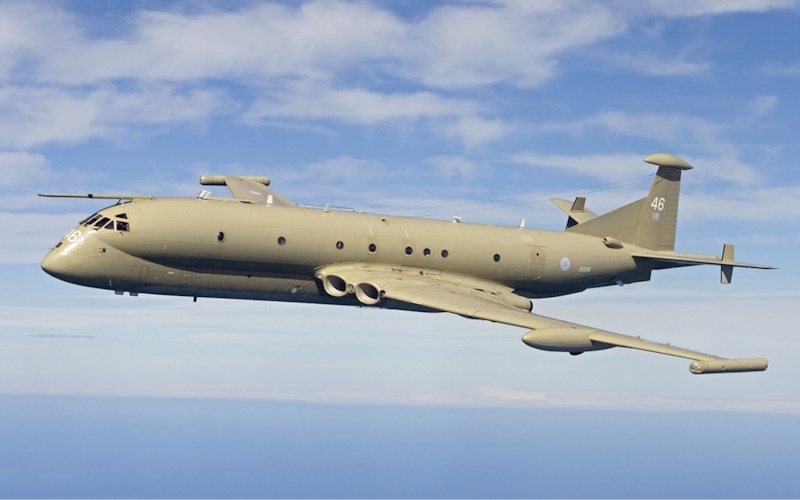
Not long after the introduction to service of the Nimrod R.1, 35 Nimrod MR.1s were updated to the much more advanced and definitive "MR.2" spec that had been intended all along, getting rid of the antiquated avionics kit inherited from the Shackleton. New kit in the MR.2 included EMI Searchwater radar, a GEC-Marconi sonobuoy acoustic processor that could handle more modern sonobuoys, a mission data recorder, and a Yellow Gate ESM -- the ESM being marked by pods on the wingtips. Some sources claim it also had a diesel-fumes "sniffer" to give hints of the presence of diesel submarines.
___________________________________________________________________
BAE NIMROD MR2
___________________________________________________________________
wingspan:
35 meters (114 feet 10 inches)
wing area:
107.04 sq_meters (2,121 sq_feet)
length:
38.63 meters (126 feet 9 inches)
height:
9.08 meters (29 feet 8 inches)
empty weight:
39,010 kilograms (86,000 pounds)
MTO weight:
87,090 kilograms (192,000 pounds)
max speed at altitude:
930 KPH (580 MPH / 500 KT)
cruise speed:
680 KPH (545 MPH / 475 KT)
patrol speed:
370 KPH (230 MPH / 200 KT)
service ceiling:
12,800 meters (42,000 feet)
range:
9,265 kilometers (5,760 MI / 5,030 NMI)
___________________________________________________________________
The heftier systems load meant the MR2 could only carry 10 additional crew. The MR2s were given updates in service, including underwing chaff-flare dispensers and a digital camera system to replace the old film camera system.
BACK_TO_TOP* In 1977, Hawker Siddeley became part of the British Aerospace (BAE) group. Work went forward at BAE on an airborne early warning (AEW) derivative of the Nimrod, the "Nimrod AEW3", to replace elderly Shackleton AEW.2 aircraft. 11 Nimrod MR airframes were converted, the first flying in 1980, many of the conversions being MR1s left over from the retirement of the Luqa squadron. The Nimrod was seen as a good AEW platform, since it appeared to be big enough to carry the required gear, and also did not have propellers that could interfere with the radar.
The Nimrod AEW3 had radomes on the nose and tail for a GEC Marconi pulse-Doppler radar, with the radome scheme trialed on a Comet 4 jetliner. Unfortunately the AEW3 development program went nowhere, a major problem being that the Nimrod airframe didn't really turn out to be big enough to do the job, the projected systems being more of a load than those of the primitive Shackleton AEW.2. Another problem being that the GEC computer tying the systems together wasn't big enough for the job either. It should be noted, as an indication of the state of computing technology at the time, that the computer had 2.4 megabytes of memory, like three orders of magnitude less than that of a modern smartphone.
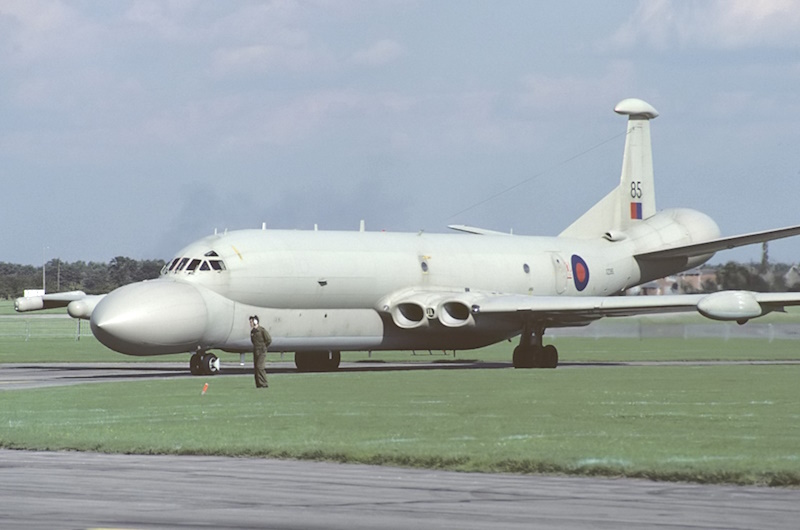
The Nimrod AEW3 was canceled in 1986, something of a scandal following the cancellation. The RAF acquired seven Boeing E-3 Sentry AEW machines instead, with the Shackleton AEW.2s finally retired in 1991. All the Nimrod AEW3 were scrapped.
* During the 1982 Falklands War, MR2s were fitted with inflight refueling (IFR) probes, and also a stores adapter to allow an MR2 to carry two AIM-9 Sidewinders air-to-air missile (AAM), for self-defense -- or possibly to attack Argentine patrol aircraft. These machines were redesignated "MR2P". In preparation for the 1990:1991 Gulf War, a number of several MR2s were fitted with new kit including a datalink, chaff-flare dispensers, a towed countermeasures decoy, and a forward-looking infrared (FLIR) turret under the right wing. They were redesignated "MR2P(GM)" -- "GM" meaning "Gulf Mod". The Nimrods performed maritime patrols during the conflict, and assisted in the sinking of a number of Iraqi vessels.
Nimrod R1s, flying out of Cyprus, participated in the conflict as well; they were also fitted with countermeasures gear. During the 1990s, the R1s were given new SIGINT systems under the STARWINDOW upgrade. One R1 was lost in a crash in 1995, with an MR2 then converted to the R1 configuration.
* Nimrods flew in support of the invasion of Afghanistan in 2001, and the invasion of Iraq in 2003. By that time the MR2 was showing its age, with BAE Systems working on another update, the "Nimrod MRA4", originally the "Nimrod 2000". The Nimrod MRA4 was intended to be a much-improved successor to the the MR2, with new Rolls-Royce BR710 turbofans and bigger engine intakes; a new and bigger wing with more fuel capacity; a fully refurbished fuselage; new hydraulic and electrical system; and updated avionics, including:
The BR710s provided 25% more thrust, while consuming 30% less fuel. The wing redesign was partly to accommodate the BR710s, which were wider than the Speys; the engine inlets were noticeably enlarged. With the new engines and more fuel, it would have almost twice the range of the MR2, and more automation meant a smaller crew as well. Three development aircraft were flown, with two pre-production machines built as well. The first development aircraft to take to the air performed its maiden flight on 26 August 2004.
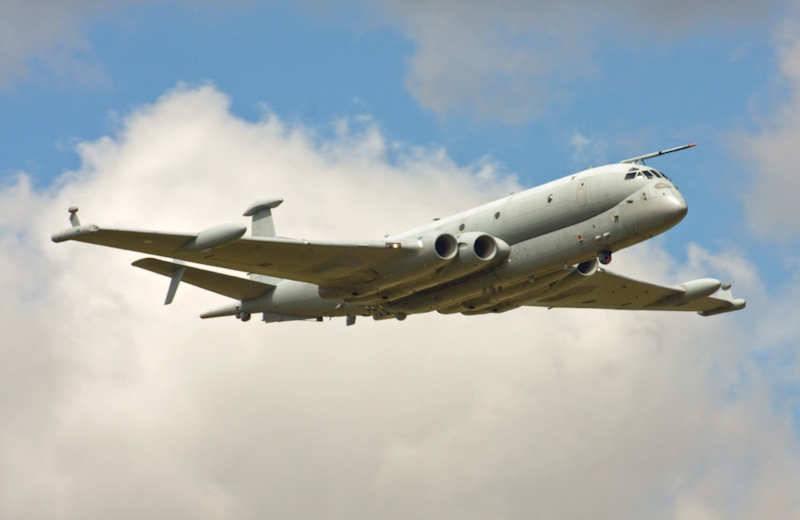
However, as with the AEW3, development stretched out, encountering one problem after another; refurbishing the old airframes turned out to be a nightmare, since they weren't built to a common standard. It seems no two Nimrods were built exactly alike, with parts for one not necessarily working in another, which made maintenance difficult. The MRA4 was canceled in 2010. All surviving Nimrods MR2s were out of service by 2010, the R1s following a year later. The Nimrod R1s were replaced by three Boeing RC-135W Rivet Joint SIGINT machines. These, incidentally, were the only RC-135s ever operated by a foreign power.
The long-range maritime reconnaissance role remained more or less in suspension, with the RAF eventually acquiring the Boeing P-8 Poseidon for the role; the P-8 went into RAF service in 2020. All the Nimrods ended up being replaced by Boeings. A number of Nimrods remain on static display, but none are flying any more.
BACK_TO_TOP* Sources included the online Wikipedia, aircraft encyclopedias, and my collection of JANE'S ALL THE WORLD'S AIRCRAFT. The Atlantic and Nimrod are not over-documented.
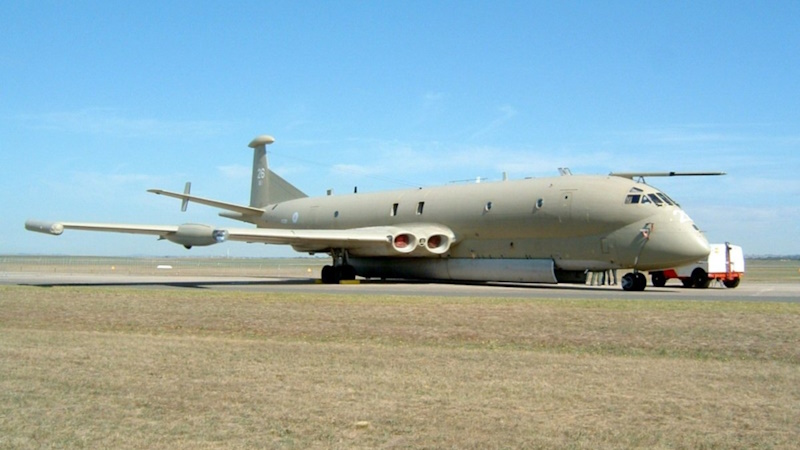
* Illustration credits:
* Revision history:
v1.0.0 / 01 sep 23 v1.0.1 / 01 sep 25 / Review & polish. (!!)BACK_TO_TOP
